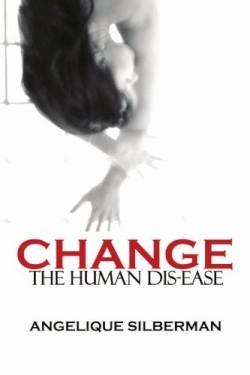Change
The Human Disease
Across cultures and generations individuals dread change. It is uncomfortable and disorienting and our inability to process change is perhaps what motivated Angelique Silberman to write this self-help book Change: The Human Dis-ease. The book contains Silberman’s personal reflections and efforts toward creating a new concept of change; she encourages readers to embrace the chaos of change as a process of self-discovery. She warns that Change will not be easy read but Silberman intended its difficultly to be in its power to inspire life-changing epiphanies and not in its unreadable sentence structure.
Change consists of twelve chapters although these divisions are made haphazardly as there is no apparent organization to the material. Three-quarters of the book is Silberman’s free-flowing musings on how individuals deal with change and how society instructs us to react. The other quarter of Change is Silberman’s personal experiences with the tribulations that change has elicited in her own life. Yet these sporadic concrete details are overpowered by her unwieldy theories on metaphysics religion and human behavior.
From the few personal details scattered throughout the book readers learn that Silberman was born in South Africa to a single mother immigrated to Canada with her husband got divorced eight years later suffered depression and after a suicide attempt was committed to a mental health institution. After being released Silberman experienced spiritual and mental breakthroughs—she even had a vision during meditation. These details are placed almost mid-text and without this backstory Silberman’s earlier observations are groundless and ineffective. If only she had thought to begin her book with these extraordinary events her words might carry more weight.
Silberman should be given credit for her attempt to use an unconventional writing style as a way to chip away at the inertia often associated with fear of change. Done well an unexpected treatment might have shined new light on an old topic. Yet Silberman’s writing style contains patterns that weaken her authority. For example she often exclaims “Bing-badda-boom!” before making a key point amounting to several “Bing-badda-booms” every other page. And Silberman’s tone is too causal; she often cites things as “bullshit” and asks “What the hell?” when she is particularly perplexed. She also writes in clichés as if evoking a common language and yet she places such clichés in quotations marks which only emphasizes their continued triteness.
In its current form Change: The Human Disease resembles a manuscript. A good editor might be able to save Silberman’s writing and with some re-organization give the book some direction. The first chapter is entitled “Is There Sense to It All” and at the end of the book readers are left answering with a resounding “No.”
Reviewed by
Amanda McCorquodale
Disclosure: This article is not an endorsement, but a review. The publisher of this book provided free copies of the book and paid a small fee to have their book reviewed by a professional reviewer. Foreword Reviews and Clarion Reviews make no guarantee that the publisher will receive a positive review. Foreword Magazine, Inc. is disclosing this in accordance with the Federal Trade Commission’s 16 CFR, Part 255.

